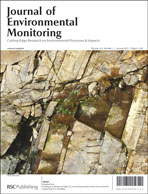
Ps. This is our favourite photo!
Dr Shinsuke Tanabe is a Professor at the Center for Marine Environmental Studies (CMES), Ehime University, Japan and is the Program Leader of the Global Center of Excellence (G-COE) Program. He established the Environmental Specimen Bank at Ehime University and his lab are currently involved in global monitoring of trace and radioactive elements, classic and novel persistent organic pollutants (POPs), and pharmaceutical and personal care products (PPCPs), especially in developing countries in Asia and Africa. They are also involved in measuring the in situ, in vivo and in ovo toxic implications of persistent chemicals like dioxins and related chemicals (DRCs) on wildlife and humans.
As you can see, his research covers the “Source, Transport and Fate” and “Exposure and Impacts” areas of our scope:
Silver speciation in liver of marine mammals by synchrotron X-ray absorption fine structure and X-ray fluorescence spectroscopies
Emiko Nakazawa, Tokutaka Ikemoto, Akiko Hokura, Yasuko Terada, Takashi Kunito, Takahito Yamamoto, Tadasu K. Yamada, Fernando C. W. Rosas, Gilberto Fillmann, Shinsuke Tanabe and Izumi Nakai
DOI: 10.1039/C1EM10115C
Spatial and temporal evolution of imposex in dogwhelk Nucella lapillus (L.) populations from North Wales, UK
Isabel Benta Oliveira, Christopher Allan Richardson, Ana Catarina Sousa, Shin Takahashi, Shinsuke Tanabe and Carlos Miguez Barroso
DOI: 10.1039/B906766C
Brominated flame retardants in the environment of Asia-Pacific: an overview of spatial and temporal trends
Shinsuke Tanabe, Karri Ramu, Tomohiko Isobe and Shin Takahashi
DOI: 10.1039/B709928B
Environmental Specimen Bank in Ehime University (es-BANK), Japan for global monitoring
Shinsuke Tanabe
DOI: 10.1039/B602677J
We asked him what he thinks will be future environmental issues:
“Emerging POPs are exclusively man-made but extremely toxic to humans, present in all our organs and tissues. The effect of POPs on humans is well known but their toxic implications will become a hot cake for scientists to deal with in the future. Also, radioactivity is actively making human life bright at present but may make it gloomy in future if emissions from atomic power plants are not controlled. There will be a need for continuous assessment of pollution from the thousands of such plants in the future.”
View the profiles for the rest of the Editorial Board here.











 Wunmi Sadik
Wunmi Sadik Professor
Professor  Professor Liang-Hong Guo is a principal investigator and group leader at the Center for Eco-environmental Sciences, Chinese Academy of Sciences. His current research interests include biosensors and bioassays for quantitative determination of environmental chemicals and chemical toxicity testing, interactions of environmental chemicals with biological molecules and their toxicological implications, and nanomaterials for water purification.
Professor Liang-Hong Guo is a principal investigator and group leader at the Center for Eco-environmental Sciences, Chinese Academy of Sciences. His current research interests include biosensors and bioassays for quantitative determination of environmental chemicals and chemical toxicity testing, interactions of environmental chemicals with biological molecules and their toxicological implications, and nanomaterials for water purification. Professor
Professor 

 In 2012 we welcome a new Chair to our Editorial Board, Frank Wania, University of Toronto and thank Professor Deborah Swackhamer for all her work as previous Chair.
In 2012 we welcome a new Chair to our Editorial Board, Frank Wania, University of Toronto and thank Professor Deborah Swackhamer for all her work as previous Chair.